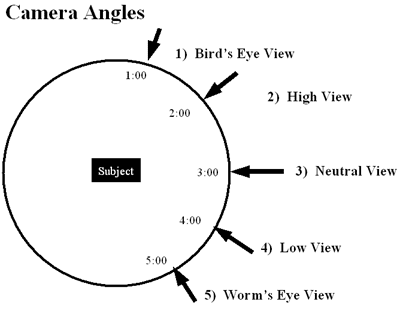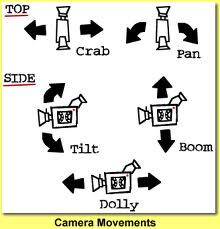| Crab | A less-common term for tracking or trucking. |
| Dolly | The camera is mounted on a cart which travels along tracks for a very smooth movement. Also known as a tracking shot or trucking shot. |
| Dolly Zoom | A technique in which the camera moves closer or further from the subject while simultaneously adjusting the zoom angle to keep the subject the same size in the frame. |
| Follow | The camera physically follows the subject at a more or less constant distance. |
| Pan | Horizontal movement, left and right. |
| Pedestal (Ped) | Moving the camera position vertically with respect to the subject. |
| Tilt | Vertical movement of the camera angle, i.e. pointing the camera up and down (as opposed to moving the whole camera up and down). |
| Track | Roughly synonymous with the dolly shot, but often defined more specifically as movement which stays a constant distance from the action, especially side-to-side movement. |
| Truck | Another term for tracking or dollying. |
| Zoomb | Technically this isn't a camera move, but a change in the lens focal length with gives the illusion of moving the camera closer or further away. 
Camera Shot Angles
1) Extreme Long Shot (ELS):
Extreme Long Shot’s are used mainly to set the scene of the movie you are trying to create. It usually shows the outside of a building or even a landscape to give the audience a brief idea of where the scene takes place.
2) Long Shot (LS):
This shot is difficult to use because it determines the actual size of an object you are trying to show. This corresponds with the real distance between the audience and the screen in a cinema or the TV.
The shot requires a FULL SHOT showing the entire human body with the head near the top of the frame and the feet near the bottom, not cropping anything out.
3) Medium Shot (MS):
A Medium Shot is usually used for dialogue scenes, only showing the human from the waist and upwards. If more than three figures are shown in the scene then this eventually becomes a long shot. People use these shots because they want the audience to concentrate more on the people and very little setting is shown – probably the director has already shown the setting of the scene before this shot and it is no longer needed to be repeated on a wide scale.
4) Close-Up Shot (CUS):
A Close-Up Shot is mainly used to concentrate on a face or a particular Mis-en-scene showing very little background. The director may choose to make the background a blur to gain the audience’s attention on what he/she wants to be mainly seen. Close-Up Shots can be focused on objects or a character’s facial expression which takes up the mind of the character.
5) Extreme Close-Up Shot (ECU):
The Extreme Close-Up Shot magnifies beyond what the human eye would imagine in reality. An extreme close-up of a face of a human would only show the eyes or the mouth covering up the whole screen with no background included. This shot is usually used to make a dramatic and tense effect.
|
Thursday, 16 August 2012
Camera Movement
Subscribe to:
Post Comments (Atom)
No comments:
Post a Comment